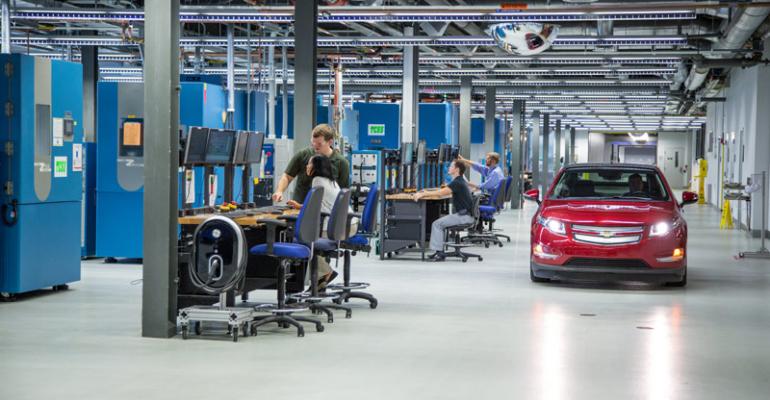WARREN, MI – Anyone thinking the electrification movement might run out of steam on the heels of slower-than-hoped electric-vehicle sales needs only to take a close look at the Frankfurt auto show, now open to the public, and what General Motors is doing right here at its tech center.
More than a dozen hybrid-electric and EV production and concept models were rolled out to the media at the Frankfurt show last week, proving even the slow-moving Germans and other diesel-centric European auto makers see the inevitable trend in electrification.
And today, GM officially opened an expansion of its Global Battery Systems Laboratory in Warren, more than doubling the floor space of what already was billed as the largest OE-owned facility of its type in North America.
In addition to more elbow room and ability to test additional battery cells and packs, the U.S. auto maker has added prototype-build capability it says is helping to optimize the power and performance of its future EVs and hybrid batteries.
The $20 million expansion adds 50,000 sq.-ft. (4,645 sq.-m) of floor space, bringing the lab’s total area to 85,000 sq.-ft. (7,897 sq.-m), increasing the number of pack-level test channels from 64 to 112 and boosting cell-testing channels from 96 to 120. Total investment in the operation now stands at $45 million.
“In the past four years, the competitive landscape in electrification space has grown exponentially,” says Doug Parks, vice president-global product programs. “This has required us to raise our game and draw a new line in the sand.”
Perhaps among the most important elements of the expanded lab is the new prototype-build capability, which Doug Drauch, lead engineer at the lab, says enables GM to “take a box of parts” and experiment with various pack layouts to optimize performance.
Prior to the new lab expansion, GM had to rely strictly on suppliers to test new theories on pack design, and generally got results that were “only about 90%” of what the auto maker was targeting, Drauch tells WardsAuto.
The new operation also allows GM to create prototype packs for vehicle-development programs and test manufacturing methodologies for ease of assembly and maximum reliability. Much of the equipment in the new manufacturing-engineering area of the lab was purchased with the help of funding from the U.S. Department of Energy, GM officials say.
The lab expansion also adds testing for battery chargers and houses a competitive benchmark operation where seven different OE battery packs currently are being examined for performance and cost characteristics.
The test lab opened in 2009, with the final phase of the new expansion completed in July. The facility includes equipment for extensive climate testing for both battery cells and packs, with test cells capable of temperatures ranging from -40º to +85º C (-40º to 185º F) and humidity from zero to 100%.
The operation, which employs about 100 people, also includes vibration testing for the battery packs and sophisticated software- and electronics-testing capability, with most of the equipment and procedures employed designed in-house.
Testing varies but can range up to two years on a cell or pack to simulate more than eight years of real-world use. GM says more than 2.5 million cells have been tested since the facility opened four years ago, as the auto maker continues to look for the next leap in lithium-ion battery technology and examines other promising new cell chemistries.
GM also has battery-testing operations in Germany and China that work closely with the U.S. operation.




